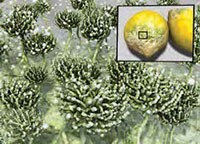Mycotoxin Analysis in Food and Feed: Detecting the Fungus Among Us

Mycotoxins are secondary metabolites produced by certain filamentous molds and fungi that can contaminate food in the field or in suboptimal storage or processing conditions post-harvest. They can be found across any number of commodities including grains, produce, spices, wine, beer, cocoa, coffee and even dairy products via secondary exposure through feed. They are resistant to decomposition and are not removed by cooking, washing or sanitizing.1
Mycotoxin production by various fungi on food and feed crops is both costly and ever-present danger to health that requires regular and reliable analytical testing. The ubiquitous presence of fungi in the environment, combined with changing climates and growing conditions can, at any time, favor the production of toxic secondary metabolites that if left undetected during food processing could result in serious poisoning or death to humans, pets and livestock.
Mycotoxin chemistry is diverse with some toxins being relatively harmless and some very dangerous at relatively low levels like aflatoxins, citrinin, ergot alkaloids fumonisins, ochratoxin A, patulin, trichothecenes, and zearalenone.2,3 Since growth and subsequent exposure to mycotoxins on grain and fruit or contamination during downstream processing is unpredictable, over 100 countries now require analytical safety testing and many have further imposed maximum acceptable limits for certain mycotoxins and commodities
In the US, for example, the US Food and Drug Administration (FDA) and the United States Department of Agriculture (USDA) work together to impose limits on mycotoxin contamination in food and feed products. Strategies used by US regulatory agencies to minimize mycotoxins in the food supply include:
- Establishing action and advisory limits for certain commodities as well as compliance policy guides (CPG) and Monitoring the food supply by collecting and analyzing domestic and import foods.4
Mitigate risks of Mycotoxin contamination before it impacts your product with accurate testing solutions
We are committed to advancing global mycotoxin detection by providing Supelco®, analytical reagents for reliable, precise testing, improved lab efficiency and regulatory expertise across the food supply chain.
Experts discuss the growing concern of Mycotoxins
Scientists from our Food Safety and Regulatory teams continue to participate in panel discussions, podcasts and webinars with mycotoxin experts around the globe to better understand the dynamic landscape of aflatoxins, patulin and other mycotoxins as a growing concern in the food space, the growing impact on the food and beverage industry and how to face the challenges around sampling and testing for mycotoxins.
Listen to some of the conversations on-demand:
Mycotoxin Madness - Food Safety Matters Podcast

Food Safety Matters podcast speaks with mycotoxin experts Sally Powell Price & Justyce Jedlicka on the rising concern of mycotoxins such as aflatoxins, mycotoxins-prevalent products, latest regulations, and compliance.
Panel Discussion: The growing concern of mycotoxins
Panel discussion with mycotoxin experts at Food Safety Live 2021. We joined food safety experts to discuss the contributing factors to mycotoxins, the importance of hot-spotting, regulatory updates and mycotoxins testing such as aflatoxins.
References
Zaloguj się lub utwórz konto, aby kontynuować.
Nie masz konta użytkownika?